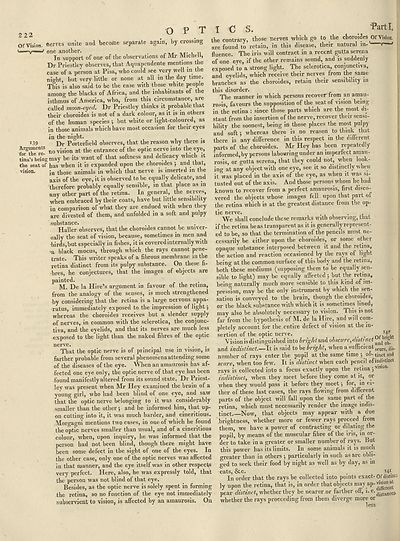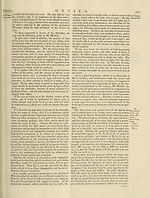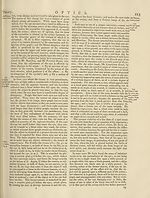Encyclopaedia Britannica > Volume 15, NIC-PAR
(242) Page 222
Download files
Complete book:
Individual page:
Thumbnail gallery: Grid view | List view

222 . 0 P .T
Gf Vision, fterves unite and become separate again, by crossing
y one another. . , n
In support of one of the observations ot Mr Michell,
Dr Priestley observes, that Aquapendente mentions the
case of a person at Pisa, who could see very well in the
night, but very little or none at all in the day time.
This is also said to be the case with those white people
among the blacks of Africa, and the inhabitants of the
isthmus of America, who, from this circumstance, are
called moon-eyed. Dr Priestley thinks it probable that
their choroides is not of a dark colour, as it is in others
of the human species } but white or light-coloured, as
in those animals which have most occasion for their eyes
in the night. , ,, •
i.39 Dr Porterfield observes, that the reason why there is
Arguments ^ vigion at the entrance of the optic nerve into the eye,
ttna’s being may be its want of that softness and delicacy which it
the seat of has when it is expanded upon the choroides j and that,
vision. jn tjlose animals in which that nerve is inserted in the
axis of the eye, it is observed to be equally delicate, and
therefore probably equally sensible, in that place as in
any other part of the retina. In general, the nerves,
when embraced by their coats, have but little sensibility
in comparison of what they are endued with when they
are divested of them, and unfolded in a soft and pulpy
substance.
Haller observes, that the choroides cannot be univer¬
sally the seat of vision, because, sometimes in men and
birds,but especially in fishes, it is covered internally with
>a black mucus, through which the rays cannot pene¬
trate. This writer speaks of a fibrous membrane in the
retina distinct from its pulpy substance. On these fi¬
bres, he conjectures, that the images of objects are
painted. _ .
M. De la Hire’s argument in favour of the retina,
from the analogy of the senses, is much strengthened
by considering that the retina is a large nervous appa¬
ratus, immediately exposed to the impression of light 3
whereas the choroides receives but a slender supply
of nerves, in common with the sclerotica, the conjunc¬
tiva, and the eyelids, and that its nerves are much less
exposed to the light than the naked fibres of the optic
nerve. _ ....
That the optic nerve is of principal use in vision, is
farther probable from several phenomena attending some
of the diseases of the eye. When an amaurosis has af¬
fected one eye only, the optic nerve of that eye has been
found manifestly altered from its sound state. Dr Priest-
lev was present when Mr Hey examined the brain ot a
young girl, who had been blind of one eye, and saw
that the optic nerve belonging to it was considerably
smaller than the other 3 and he informed him, that up¬
on cutting into it, it was much harder, and cineritious.
Morgagni mentions two cases, in one of which he found
the optic nerves smaller than usual, and of a cineritious
colour, when, upon inquiry, lie was informed that the
person had not been blind, though there might have
been some defect in the sight of one of the eyes. In
the other case, only one of the optic nerves was affected
In that manner, and the eye itself was in other respects
very perfect. Here, also, he was expressly told, that
the person was not blind of that eye.
Besides, as the optic nerve is solely spent in forming
the retina, so no function of the eye not immediately
subservient to vision, is affected by an amaurosis. On
I C S. , Part1-
the contrary, those nerves which go to the choroides Of Vision,
are found to retain, in this disease, their natural in-' » r
fluence. The iris will contract in a recent gutta serena
of one eye, if the other remains sound, and is suddenly
exposed to a strong light. The sclerotica, conjunctiva,
and eyelids, which receive their nerves from the same
branches as the choroides, retain their sensibility in
this disorder.
The manner in which persons recover from an amau¬
rosis, favours the supposition of the seat of vision being
in the retina : since those parts which are the most di¬
stant from the insertion of the nerve, recover their sensi¬
bility the soonest, being in those places the most pulpy
and soft 3 whereas there is no reason to think that
there is any difference in this respect in the different
parts of the choroides. Mr Hey has been repeatedly
informed, by persons labouring under an imperfect amau¬
rosis, or gutta serena, that they could not, when look¬
ing at any object with one eye, see it so distinctly when
it was placed in the axis of the eye, as when it was si¬
tuated out of the axis. And those persons whom he had
known to recover from a perfect amaurosis, first disco¬
vered the objects whose images fell upon that part of
the retina which is at the greatest distance from the op¬
tic nerve. ( . r
We shall conclude these remarks with observing, that
If the retina be as transparent as it is generally represent¬
ed to be, so that the termination of the pencils must ne¬
cessarily be either upon the choroides, or some other
opaque substance interposed between it and the retina,
the action and reaction occasioned by the rays of light
being at the common surface ot this body and the retina,
both these mediums (supposing them to be equally sen¬
sible to light) may be equally affected 3 but the retina,
being naturally much more sensible to this kind of im¬
pression, may be the only instrument by which the sen¬
sation is conveyed to the brain, though the. choroides,
or the black substance with which it is sometimes lined,
may also be absolutely necessary to vision. 1 his is not
far from the hypothesis of M. de la Hire, and will com¬
pletely account for the entire defect of vision at the in¬
sertion of the optic nerve. . # ofbne-kt
Vision is distinguished into bright and obscure, distinct ^ £
and indistinct.—It is said to be bright, when a sufficient scurei dij.
number of rays enter the pupil at the same time ; oi-tinct and
scure, when too few. It is distinct when each pencil of indistinct
rays is collected into a focus exactly upon the retina 3 vl51°
indistinct, when they meet before they come at it, or
when they would pass it before they meet 3 for, in ei¬
ther of these last cases, the rays flowing from different
parts of the object will fall upon the same part of the
retina, which must necessarily render the image indis¬
tinct.—Now, that objects may appear with a due
brightness, whether more or fewer rays proceed from
them, we have a power of contracting or dilating the
pupil, by means of the muscular fibre of the iris, in or¬
der to take in a greater or smaller number of rays. But
this power has its limits. In some animals it is much
greater than in others 3 particularly in such as are obli¬
ged to seek their food by night as well as by day, as in
Celts &LC* 141
In order that the rays be collected into points exact- Of distinc;
ly upon the retina, that is, in order that objects may ap-vmonat
pear distinct, whether they be nearer or farther off, 1.e- d|stancc?
whether the rays proceeding from them diverge more or
less
Gf Vision, fterves unite and become separate again, by crossing
y one another. . , n
In support of one of the observations ot Mr Michell,
Dr Priestley observes, that Aquapendente mentions the
case of a person at Pisa, who could see very well in the
night, but very little or none at all in the day time.
This is also said to be the case with those white people
among the blacks of Africa, and the inhabitants of the
isthmus of America, who, from this circumstance, are
called moon-eyed. Dr Priestley thinks it probable that
their choroides is not of a dark colour, as it is in others
of the human species } but white or light-coloured, as
in those animals which have most occasion for their eyes
in the night. , ,, •
i.39 Dr Porterfield observes, that the reason why there is
Arguments ^ vigion at the entrance of the optic nerve into the eye,
ttna’s being may be its want of that softness and delicacy which it
the seat of has when it is expanded upon the choroides j and that,
vision. jn tjlose animals in which that nerve is inserted in the
axis of the eye, it is observed to be equally delicate, and
therefore probably equally sensible, in that place as in
any other part of the retina. In general, the nerves,
when embraced by their coats, have but little sensibility
in comparison of what they are endued with when they
are divested of them, and unfolded in a soft and pulpy
substance.
Haller observes, that the choroides cannot be univer¬
sally the seat of vision, because, sometimes in men and
birds,but especially in fishes, it is covered internally with
>a black mucus, through which the rays cannot pene¬
trate. This writer speaks of a fibrous membrane in the
retina distinct from its pulpy substance. On these fi¬
bres, he conjectures, that the images of objects are
painted. _ .
M. De la Hire’s argument in favour of the retina,
from the analogy of the senses, is much strengthened
by considering that the retina is a large nervous appa¬
ratus, immediately exposed to the impression of light 3
whereas the choroides receives but a slender supply
of nerves, in common with the sclerotica, the conjunc¬
tiva, and the eyelids, and that its nerves are much less
exposed to the light than the naked fibres of the optic
nerve. _ ....
That the optic nerve is of principal use in vision, is
farther probable from several phenomena attending some
of the diseases of the eye. When an amaurosis has af¬
fected one eye only, the optic nerve of that eye has been
found manifestly altered from its sound state. Dr Priest-
lev was present when Mr Hey examined the brain ot a
young girl, who had been blind of one eye, and saw
that the optic nerve belonging to it was considerably
smaller than the other 3 and he informed him, that up¬
on cutting into it, it was much harder, and cineritious.
Morgagni mentions two cases, in one of which he found
the optic nerves smaller than usual, and of a cineritious
colour, when, upon inquiry, lie was informed that the
person had not been blind, though there might have
been some defect in the sight of one of the eyes. In
the other case, only one of the optic nerves was affected
In that manner, and the eye itself was in other respects
very perfect. Here, also, he was expressly told, that
the person was not blind of that eye.
Besides, as the optic nerve is solely spent in forming
the retina, so no function of the eye not immediately
subservient to vision, is affected by an amaurosis. On
I C S. , Part1-
the contrary, those nerves which go to the choroides Of Vision,
are found to retain, in this disease, their natural in-' » r
fluence. The iris will contract in a recent gutta serena
of one eye, if the other remains sound, and is suddenly
exposed to a strong light. The sclerotica, conjunctiva,
and eyelids, which receive their nerves from the same
branches as the choroides, retain their sensibility in
this disorder.
The manner in which persons recover from an amau¬
rosis, favours the supposition of the seat of vision being
in the retina : since those parts which are the most di¬
stant from the insertion of the nerve, recover their sensi¬
bility the soonest, being in those places the most pulpy
and soft 3 whereas there is no reason to think that
there is any difference in this respect in the different
parts of the choroides. Mr Hey has been repeatedly
informed, by persons labouring under an imperfect amau¬
rosis, or gutta serena, that they could not, when look¬
ing at any object with one eye, see it so distinctly when
it was placed in the axis of the eye, as when it was si¬
tuated out of the axis. And those persons whom he had
known to recover from a perfect amaurosis, first disco¬
vered the objects whose images fell upon that part of
the retina which is at the greatest distance from the op¬
tic nerve. ( . r
We shall conclude these remarks with observing, that
If the retina be as transparent as it is generally represent¬
ed to be, so that the termination of the pencils must ne¬
cessarily be either upon the choroides, or some other
opaque substance interposed between it and the retina,
the action and reaction occasioned by the rays of light
being at the common surface ot this body and the retina,
both these mediums (supposing them to be equally sen¬
sible to light) may be equally affected 3 but the retina,
being naturally much more sensible to this kind of im¬
pression, may be the only instrument by which the sen¬
sation is conveyed to the brain, though the. choroides,
or the black substance with which it is sometimes lined,
may also be absolutely necessary to vision. 1 his is not
far from the hypothesis of M. de la Hire, and will com¬
pletely account for the entire defect of vision at the in¬
sertion of the optic nerve. . # ofbne-kt
Vision is distinguished into bright and obscure, distinct ^ £
and indistinct.—It is said to be bright, when a sufficient scurei dij.
number of rays enter the pupil at the same time ; oi-tinct and
scure, when too few. It is distinct when each pencil of indistinct
rays is collected into a focus exactly upon the retina 3 vl51°
indistinct, when they meet before they come at it, or
when they would pass it before they meet 3 for, in ei¬
ther of these last cases, the rays flowing from different
parts of the object will fall upon the same part of the
retina, which must necessarily render the image indis¬
tinct.—Now, that objects may appear with a due
brightness, whether more or fewer rays proceed from
them, we have a power of contracting or dilating the
pupil, by means of the muscular fibre of the iris, in or¬
der to take in a greater or smaller number of rays. But
this power has its limits. In some animals it is much
greater than in others 3 particularly in such as are obli¬
ged to seek their food by night as well as by day, as in
Celts &LC* 141
In order that the rays be collected into points exact- Of distinc;
ly upon the retina, that is, in order that objects may ap-vmonat
pear distinct, whether they be nearer or farther off, 1.e- d|stancc?
whether the rays proceeding from them diverge more or
less
Set display mode to:
![]() Universal Viewer |
Universal Viewer | ![]() Mirador |
Large image | Transcription
Mirador |
Large image | Transcription
Images and transcriptions on this page, including medium image downloads, may be used under the Creative Commons Attribution 4.0 International Licence unless otherwise stated. ![]()
| Encyclopaedia Britannica > Encyclopaedia Britannica > Volume 15, NIC-PAR > (242) Page 222 |
|---|
| Permanent URL | https://digital.nls.uk/192584844 |
|---|
| Attribution and copyright: |
|
|---|
| Shelfmark | EB.11 |
|---|---|
| Description | Ten editions of 'Encyclopaedia Britannica', issued from 1768-1903, in 231 volumes. Originally issued in 100 weekly parts (3 volumes) between 1768 and 1771 by publishers: Colin Macfarquhar and Andrew Bell (Edinburgh); editor: William Smellie: engraver: Andrew Bell. Expanded editions in the 19th century featured more volumes and contributions from leading experts in their fields. Managed and published in Edinburgh up to the 9th edition (25 volumes, from 1875-1889); the 10th edition (1902-1903) re-issued the 9th edition, with 11 supplementary volumes. |
|---|---|
| Additional NLS resources: |
|

